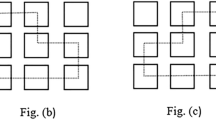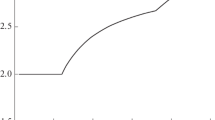Abstract
In this paper, a new method for the construction of the exponent matrix of quasi-cyclic low-density parity-check (QC-LDPC) codes is proposed. The entries of the exponent matrix are based on the column multipliers. To find the column multipliers, a parameter \( {\varvec{S}_{\varvec{\alpha}}} \) is defined which gives the value of column multiplier of the \( {\varvec{\alpha}} \)th column. The proposed method reduced the complexity related to the formation of the exponent matrix and results in (3,L)-QC-LDPC codes with girth at least eight, for \( {\varvec{L} > 3} \). Also, a lower bound on the size of the circulant permutation matrix (CPM) for a QC-LDPC code is derived, and the codes constructed by this method are optimal to the given bound. Further, most of the codes constructed using this method are of smaller CPM size. Specifically, for \( {\varvec{L} > 25} \), our constructed QC-LDPC codes have the shortest CPM size compared to the existing ones in the literature.
Similar content being viewed by others
References
Amirzade F., Sadeghi M.R.: Lower bounds on the lifting degree of QC-LDPC codes by difference matrices. IEEE Access. 6, 23688–23700 (2018).
Draft DVB-S2 Standard: ETSI EN 302 307-1 V1.4.1. https://www.dvb.org/standards/dvb-s2 (2014). Accessed 23 January 2018.
Fossorier M.P.C.: Quasi-cyclic low-density parity-check codes from circulant permutation matrices. IEEE Trans. Inf. Theory 50(8), 1788–1793 (2004).
Gholami M., Gholami Z.: An explicit method to generate some QC-LDPC codes with girth 8. Iran. J. Sci. Technol. Trans. A Sci. 40(2), 145–149 (2016).
Karimi M., Banihashemi A.H.: On the girth of quasi-cyclic protograph LDPC codes. IEEE Trans. Inf. Theory 59(7), 4542–4552 (2013).
Khodaiemehr H., Sadeghi M.R., Sakzad A.: Practical encoder and decoder for power constrained QC LDPC-lattice codes. IEEE Trans. Commun. 65(2), 486–500 (2017).
Kim K.J., Chung J.H., Yang K.: Bounds on the size of parity-check matrices for quasi-cyclic low-density parity-check codes. IEEE Trans. Inf. Theory 59(11), 7288–7298 (2013).
Li L., Li H., Li J., Jiang H.: Construction of type-II QC-LDPC codes with fast encoding based on perfect cyclic difference sets. Optoelectron. Lett. 13(5), 358–362 (2017).
Mao Y., Banihashemi A.H.: A heuristic search for good low-density parity-check codes at short block lengths. Proc. IEEE ICC. 1, 41–44 (2001).
Mellinger K.E.: LDPC codes from triangle-free line sets. Des. Codes Cryptogr. 32(1–3), 341–350 (2004).
Sadeghi M., Amirzade F.: Analytical lower bound on the lifting degree of multiple-edge QC-LDPC codes with girth 6. IEEE Commun. Lett. 22(8), 1528–1531 (2018).
Sakzad A., Sadeghi M., Panario D.: Codes with girth 8 tanner graph representation. Des. Codes Cryptogr. 57(1), 71–81 (2010).
Tasdighi A., Banihashemi A.H., Sadeghi M.R.: Efficient search of girth-optimal QC-LDPC codes. IEEE Trans. Inf. Theory 62(4), 1552–1564 (2016).
Tasdighi A., Banihashemi A.H., Sadeghi M.R.: Symmetrical constructions for regular girth-8 QC-LDPC codes. IEEE Trans. Commun. 65(1), 14–22 (2017).
Vandendriessche P.: Some low-density parity-check codes derived from finite geometries. Des. Codes Cryptogr. 54(3), 287–297 (2010).
Yuan J., Liang M., Wang Y., Lin J., Pang Y.: A novel construction method of QC-LDPC codes based on CRT for optical communications. Optoelectron. Lett. 12(3), 208–211 (2016).
Zhang G., Sun R., Wang X.: Construction of girth-eight QC-LDPC codes from greatest common divisor. IEEE Commun. Lett. 17(2), 369–372 (2013).
Zhang G., Sun R., Wang X.: Several explicit constructions for (3, L)-QC-LDPC codes with girth at least eight. IEEE Commun. Lett. 17(9), 1822–1825 (2013).
Zhang J., Zhang G.: Deterministic girth-eight QC-LDPC codes with large column weight. IEEE Commun. Lett. 18(4), 656–659 (2014).
Zhang L., Li B., Cheng L.: Constructions of QC-LDPC codes based on integer sequences. Sci. China Inf. Sci. 57(6), 1–14 (2014).
Author information
Authors and Affiliations
Corresponding author
Additional information
Communicated by D. Panario.
Publisher's Note
Springer Nature remains neutral with regard to jurisdictional claims in published maps and institutional affiliations.
Rights and permissions
About this article
Cite this article
Singh, J., Gupta, M. & Bhullar, J.S. Construction of girth-8 (3,L)-QC-LDPC codes of smallest CPM size using column multipliers. Des. Codes Cryptogr. 88, 41–49 (2020). https://doi.org/10.1007/s10623-019-00667-0
Received:
Revised:
Accepted:
Published:
Issue Date:
DOI: https://doi.org/10.1007/s10623-019-00667-0




